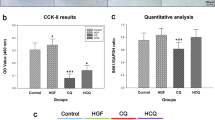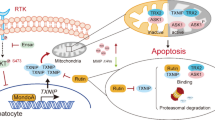Summary
Siegesbeckia pubescens (SP) has been used as a traditional medicine for the treatment of and inflammatory diseases. However, the activities of SP against hepatocellular carcinoma and the related mechanisms remain unclear. The present study aimed to examine the effects of the essential oil of SP (SPEO) on the proliferation of hepatocellular carcinoma cells and the possible mechanisms. The growth inhibition of HepG2 cells was analyzed by MTT assay. Hoechst 33258 and fluorescence microscopy were utilized to observe the nuclear morphological changes of apoptotic cells. Flow cytometry was used to detect cell apoptosis and cell cycle. The expressions of the target proteins were detected by Western blotting. The results showed that SPEO obviously inhibited the proliferation of HepG2 cells in a dose-dependent manner. SPEO activated a series of apoptotic proteins in HepG2 cells, increasing expression levels of Bax, caspase-3 and caspase-9, and decreasing the bcl-2 expression level. SPEO displayed promising anti-hepatocellular carcinoma activities in vitro, partly by inducing apoptosis in HepG2 cells through activating the mitochondrial pathway.
Similar content being viewed by others
References
Fitzmaurice C, Dicker D, Pain A, et al. The global burden of cancer 2013. JAMA Oncology, 2015,1(4): 505–527
Yin BP, Li BS. Research progress on anti-hepatoma mechanisms of traditional Chinese medicine. World Clin Drugs, 2010,7: 429–432
Wang Y, Wang J, Wang H, et al. Novel taxane derivatives from Taxus wallichiana with high anticancer potency on tumor cells. Chem Biol Drug Des, 2016,88(4): 556–561
Lu Y, Hou SX, Chen T. Advances in the study of vincristine: an anticancer ingredient from Catharanthus roseus. Zhongguo Zhong Yao Za Zhi (Chinese), 2003,28(11): 1006–1009
Wang J, Cai Y, Wu Y. Antiinflammatory and analgesic activity of topical administration of Siegesbeckia pubescens. Pak J Pharm Sci, 2008,21(2): 89–91
Li H, Kim JY, Hyeon J, et al. In vitro antiinflammatory activity of a new sesquiterpene lactone isolated from Siegesbeckia glabrescens. Phytother Res, 2011,25(9): 1323–1327
Huh JE, Baek YH, Lee JD, et al. Therapeutic effect of Siegesbeckia pubescens on cartilage protection in a rabbit collagenase-induced model of osteoarthritis. J Pharmacol Sci, 2008,107(3): 317–328
Chang CC, Hsu HF, Huang KH, et al. Anti-proliferative effects of Siegesbeckia orientalis ethanol extract on human endometrial RL-95 cancer cells. Molecules, 2014,19(12): 19980–19994
Song P, Wang Q, Lv J, et al. HPLC-based activity profiling of anti-hepatocellular carcinoma constituents from the Tibetan medicine, Caragana tibetica. J Huazhong Univ Sci Technol Med Sci, 2015,35(3): 450–455
Adams RP. Identification of essential oil components by gas chromatography/mass spectroscopy. J Am Soc Mass Spect, 1997,6(8): 671–672
Agnihotri VK, Thappa RK, Meena B, et al. Essential oil composition of aerial parts of Angelica glauca growing wild in North-West Himalaya. Phytochemistry, 2004, 65(16): 2411–2413
Tabanca N, Demirci B, Ozek T, et al. Gas chromatographic–mass spectrometric analysis of essential oils from Pimpinella species gathered from Central and Northern Turkey. J Chromatogr A, 2006,1117(2): 194–205
Roshan S, Banafa A. Fucoidan induces apoptosis of HepG2 cells by down-regulating p-Stat3. J Huazhong Univ Sci Technol Med Sci, 2014,34(3): 330–336
Zhang Z, Zou J, Huang Y, et al. Kinetin inhibits proliferation of hepatic stellate cells by interrupting cell cycle and induces apoptosis by down-regulating ratio of Bcl-2/Bax. J Huazhong Univ Sci Technol Med Sci, 2015,35(5): 672–678
Yang JA, Li JQ, Shao LM, et al. Puerarin inhibits proliferation and induces apoptosis in human glioblastoma cell lines. Int J Clin Exp Med, 2015,8(6):10132
Cai X, Ye T, Liu C, et al. Luteolin induced G2 phase cell cycle arrest and apoptosis on non-small cell lung cancer cells. Toxicol In Vitro, 2011,25(7): 1385–1391
Kim HJ, Ko HY, Choi SW, et al. Anti-angiogenic effects of Siegesbeckia glabrescens are mediated by suppression of the Akt and p70S6K-dependent signaling pathways. Oncol Rep, 2015,33(2): 699–704
Yang T, Yao S, Zhang X, et al. Andrographolide inhibits growth of human T-cell acute lymphoblastic leukemia Jurkat cells by downregulation of PI3K/AKT and upregulation of p38 MAPK pathways. Drug Des Dev Ther, 2016, 10: 1389
Vilarinho S, Taddei T. Therapeutic strategies for hepatocellular carcinoma: new advances and challenges. Curr Treat Options Gastroenterol, 2015,13(2): 219–234
Qiu N, Liu X, Tang J, et al. CDDP treatment promoting tumor growth and metastasis. Nanomedicine, 2016,12(2): 467–468
Bates DJP, Lewis LD, Eastman A, et al. Vincristine activates c-Jun N-terminal kinase in chronic lymphocytic leukaemia in vivo. Br J Clin Pharmacol, 2015,80(3): 493–501
Zhang Z, Wang A, Li H, et al. STAT3-dependent TXNDC17 expression mediates Taxol resistance through inducing autophagy in human colorectal cancer cells. Gene, 2016,584(1): 75–82
Zhou Y, Zhao H Y, Jiang D, et al. Low toxic and high soluble camptothecin derivative 2–47 effectively induces apoptosis of tumor cells in vitro. Biochem Bioph Res Commun, 2016,472(3): 477–481
Tang X, Dai H, Zhu Y, et al. Maytansine-loaded star-shaped folate-core PLA-TPGS nanoparticles enhancing anticancer activity. Am J Transl Res, 2014,6(5): 528–537
Mai WY, Lin MF. Induction of apoptosis by homoharringtonine in G1 phase human chronic myeloid leukemic cells. Chin Med J, 2005,118(6): 487–492
Zhou KY, Ji HL, Shi PF. Effect of matrine on cell apoptosis and proliferation and the apoptosis related proteins of human medulloblastoma D341 cells in vitro. Chin J Appl Physiol (Chinese), 2016,32(1): 74–77
Zhang C, Wu S, Lou Z, et al. Research progress on chemical composition, pharmacological action & clinical application of Herba Siegesbeckiae. Anhui Med Pharm J (Chinese), 2011,15(3): 274–276
Wang R, Shi YP, Wang QZ, et al. Chemical constituents from traditional Chinese medicine Siegesbeckia pubescens. Zhongguo Zhong Yao Za Zhi (Chinese), 2014,39(24): 4811–4815.
Xiong S, Mu T, Wang G, et al. Mitochondria-mediated apoptosis in mammals. Protein Cell, 2014,5(10): 737–749
Wu C, Geng X, Wan S, et al. Cecropin-P17, an analog of Cecropin B, inhibits human hepatocellular carcinoma cell HepG-2 proliferation via regulation of ROS, Caspase, Bax, and Bcl-2. J Pept Sci, 2015,21(8): 661–668
O’Neill KL, Huang K, Zhang J, et al. Inactivation of prosurvival Bcl-2 proteins activates Bax/Bak through the outer mitochondrial membrane. Gene Dev, 2016, 30(8): 973–988
Zou J, Chen Q, Jin X, et al. Olaquindox induces apoptosis through the mitochondrial pathway in HepG2 cells. Toxicology, 2011,285(3): 104–113
Author information
Authors and Affiliations
Corresponding authors
Additional information
Both authors contributed equally to this work.
This project was financially supported by grants from the Major Research Project of Education Department of Hubei Province of China (No. D20131103), National Natural Science Foundation of China (No. 81573561) and the Introduction Project of Hangzhou Medical College, Zhejiang Province, China (No. 2015B08).
Rights and permissions
About this article
Cite this article
Lv, D., Guo, Kw., Xu, C. et al. Essential oil from Siegesbeckia pubescens induces apoptosis through the mitochondrial pathway in human HepG2 cells. J. Huazhong Univ. Sci. Technol. [Med. Sci.] 37, 87–92 (2017). https://doi.org/10.1007/s11596-017-1699-7
Received:
Revised:
Published:
Issue Date:
DOI: https://doi.org/10.1007/s11596-017-1699-7




